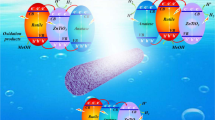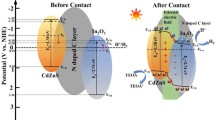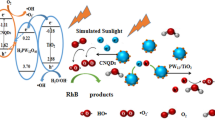Abstract
In this study, a g-C3N4-Cu2O-TiO2 photocatalyst with a novel three-dimensional ordered macroporous (3DOM) structure was successfully prepared using a sacrificial template strategy and a photodeposition method. The influence of the special porous structure with cross pore channels on the photocatalytic properties of the as-prepared sample was studied in detail. Compared with the original photocatalyst (TiO2 with 3 wt% Pt), g-C3N4-Cu2O-TiO2 exhibited a higher specific surface area and more active sites, thus accelerating the separation efficiency of the photogenerated electron-hole pair. Consequently, the as-prepared photocatalyst showed good photocatalytic performance, reaching a maximum hydrogen production rate of 12,108 µmol g−1 h−1 and approximately five times higher than that of the pristine comparison sample. The enhanced photoactivity of the g-C3N4-Cu2O-TiO2 heterojunction can be ascribed to its double p-n heterojunction and robust porous structure, where the photodeposited Cu2O plays a synergistic catalytic role in the photocatalytic process and the outer clad g-C3N4 layer prevents Cu2O oxidation. Additionally, the possible photocatalytic mechanism was briefly discussed based on the experimental results. This work identifies viable pathways for developing low-cost heterojunction photocatalysts with highly efficient photocatalytic activity toward improved solar energy conversion.
摘要
本文通过模板法与光沉积法成功制备了具有三维有序多孔结构的g-C3N4-Cu2O-TiO2光催化剂, 并详细研究了特殊多孔结构对原制备样品光催化性能的影响. 与原有的光催化剂相比, 多孔结构的g-C3N4-Cu2O-TiO2具有更高的比表面积和更多的活性位点, 从而加速了光生电子-空穴的分离效率. 因而, 该光催化剂表现出良好的光催化性能, 最大产氢率可达12,108 μmol g−1 h−1, 是原始对比样品产氢率的5倍左右. g-C3N4-Cu2O-TiO2对于光催化性能的增强可归因于其双p-n异质结和稳健的多孔结构. 此外, 光沉积Cu2O在光催化过程中起协同催化作用, 外层包覆的g-C3N4层保护Cu2O以防止催化剂氧化. 此外, 本文探究了该催化剂的光催化机理. 本工作为开发具有高效光催化活性的低成本异质结光催化剂开辟了新途径.
Similar content being viewed by others
References
Appel J, Hueren V, Boehm M, et al. Cyanobacterial in vivo solar hydrogen production using a photosystem I-hydrogenase (PsaD-HoxYH) fusion complex. Nat Energy, 2020, 5: 458–467
Takata T, Jiang J, Sakata Y, et al. Photocatalytic water splitting with a quantum efficiency of almost unity. Nature, 2020, 581: 411–414
Lu X, Xie S, Yang H, et al. Photoelectrochemical hydrogen production from biomass derivatives and water. Chem Soc Rev, 2014, 43: 7581–7593
Young JL, Steiner MA, Döscher H, et al. Direct solar-to-hydrogen conversion via inverted metamorphic multi-junction semiconductor architectures. Nat Energy, 2017, 2: 17028
Tayebi M, Lee BK. Recent advances in BiVO4 semiconductor materials for hydrogen production using photoelectrochemical water splitting. Renew Sustain Energy Rev, 2019, 111: 332–343
Nakata K, Fujishima A. TiO2 photocatalysis: Design and applications. J Photochem Photobiol C-Photochem Rev, 2012, 13: 169–189
Guo Q, Zhou C, Ma Z, et al. Fundamentals of TiO2 photocatalysis: Concepts, mechanisms, and challenges. Adv Mater, 2019, 31: 1901997
Liu R, Zheng Z, Spurgeon J, et al. Enhanced photoelectrochemical water-splitting performance of semiconductors by surface passivation layers. Energy Environ Sci, 2014, 7: 2504–2517
Li W, Elzatahry A, Aldhayan D, et al. Core-shell structured titanium dioxide nanomaterials for solar energy utilization. Chem Soc Rev, 2018, 47: 8203–8237
Wu M, Gong Y, Nie T, et al. Template-free synthesis of nanocage-like g-C3N4 with high surface area and nitrogen defects for enhanced photocatalytic H2 activity. J Mater Chem A, 2019, 7: 5324–5332
Wu M, Zhang J, He B, et al. In-situ construction of coral-like porous P-doped g-C3N4 tubes with hybrid 1D/2D architecture and high efficient photocatalytic hydrogen evolution. Appl Catal B-Environ, 2019, 241: 159–166
Kim DH, Lee MH, Kim BG, et al. Porosity controlled carbon-based 3D anode for lithium metal batteries by a slurry based process. Chem Commun, 2020, 56: 13040–13043
Zhang J, Wu M, He B, et al. Facile synthesis of rod-like g-C3N4 by decorating Mo2C co-catalyst for enhanced visible-light photocatalytic activity. Appl Surf Sci, 2019, 470: 565–572
Wu M, Zhang J, Liu C, et al. Rational design and fabrication of noble-metal-free NixP cocatalyst embedded 3D N-TiO2/g-C3N4 heterojunctions with enhanced photocatalytic hydrogen evolution. ChemCatChem, 2018, 10: 3069–3077
Gu W, Lu F, Wang C, et al. Face-to-face interfacial assembly of ultrathin g-C3N4 and anatase TiO2 nanosheets for enhanced solar photocatalytic activity. ACS Appl Mater Interfaces, 2017, 9: 28674–28684
Cai J, Wu X, Li Y, et al. Noble metal sandwich-like TiO2@Pt@C3N4 hollow spheres enhance photocatalytic performance. J Colloid Interface Sci, 2018, 514: 791–800
Pan X, Xu YJ. Defect-mediated growth of noble-metal (Ag, Pt, and Pd) nanoparticles on TiO2 with oxygen vacancies for photocatalytic redox reactions under visible light. J Phys Chem C, 2013, 117: 17996–18005
Yu J, Wang S, Cheng B, et al. Noble metal-free Ni(OH)2-g-C3N4 composite photocatalyst with enhanced visible-light photocatalytic H2-production activity. Catal Sci Technol, 2013, 3: 1782
Zhou X, Wu J, Li Q, et al. Carbon decorated In2O3/TiO2 heterostructures with enhanced visible-light-driven photocatalytic activity. J Catal, 2017, 355: 26–39
Mao Z, Chen J, Yang Y, et al. Novel g-C3N4/CoO nanocomposites with significantly enhanced visible-light photocatalytic activity for H2 evolution. ACS Appl Mater Interfaces, 2017, 9: 12427–12435
Zhao H, Jiang P, Cai W. Graphitic C3N4 decorated with CoP co-catalyst: Enhanced and stable photocatalytic H2 evolution activity from water under visible-light irradiation. Chem Asian J, 2017, 12: 361–365
Cheng H, Lv XJ, Cao S, et al. Robustly photogenerating H2 in water using FeP/CdS catalyst under solar irradiation. Sci Rep, 2016, 6: 19846
Zeng D, Ong WJ, Zheng H, et al. Ni12P5 nanoparticles embedded into porous g-C3N4 nanosheets as a noble-metal-free hetero-structure photocatalyst for efficient H2 production under visible light. J Mater Chem A, 2017, 5: 16171–16178
Lv J, Zhang J, Liu J, et al. Bi SPR-promoted Z-scheme Bi2MoO6/CdS-diethylenetriamine composite with effectively enhanced visible light photocatalytic hydrogen evolution activity and stability. ACS Sustain Chem Eng, 2018, 6: 696–706
Xiang Q, Yu J, Jaroniec M. Synergetic effect of MoS2 and graphene as cocatalysts for enhanced photocatalytic H2 production activity of TiO2 nanoparticles. J Am Chem Soc, 2012, 134: 6575–6578
Yin L, Yuan YP, Cao SW, et al. Enhanced visible-light-driven photocatalytic hydrogen generation over g-C3N4 through loading the noble metal-free NiS2 cocatalyst. RSC Adv, 2014, 4: 6127–6132
Zhang Z, Liu K, Feng Z, et al. Hierarchical sheet-on-sheet ZnIn2S4/g-C3N4 heterostructure with highly efficient photocatalytic H2 production based on photoinduced interfacial charge transfer. Sci Rep, 2016, 6: 19221
Chen W, Wang Y, Liu S, et al. Non-noble metal Cu as a cocatalyst on TiO2 nanorod for highly efficient photocatalytic hydrogen production. Appl Surf Sci, 2018, 445: 527–534
Nie J, Patrocinio AOT, Hamid S, et al. New insights into the plasmonic enhancement for photocatalytic H2 production by Cu-TiO2 upon visible light illumination. Phys Chem Chem Phys, 2018, 20: 5264–5273
Lu Y, Zhang X, Chu Y, et al. Cu2O nanocrystals/TiO2 microspheres film on a rotating disk containing long-afterglow phosphor for enhanced round-the-clock photocatalysis. Appl Catal B-Environ, 2018, 224: 239–248
Sabzehei K, Hadavi SH, Bajestani MG, et al. Comparative evaluation of copper oxide nano-photocatalyst characteristics by formation of composite with TiO2 and ZnO. Solid State Sci, 2020, 107: 106362
Wu C, Qiu L, Li S, et al. High sensitive and stable self-powered solarblind photodetector based on solution-processed all inorganic CuMO2/Ga2O3 p-n heterojunction. Mater Today Phys, 2021, 17: 100335
Shin GH, Park C, Lee KJ, et al. Ultrasensitive phototransistor based on WSe2-MoS2 van der Waals heterojunction. Nano Lett, 2020, 20: 5741–5748
Jeong G, Jung S, Choi Y, et al. A highly robust and stable grapheneencapsulated Cu-grid hybrid transparent electrode demonstrating superior performance in organic solar cells. J Mater Chem A, 2018, 6: 24805–24813
Bhattacharjee A, Morya V, Ghoroi C. Enzyme-mimetic activity of sugar cane juice stabilized CuO nanospheres and CuO/GO nanocomposite: Green synthesis and applications. Colloid Interface Sci Commun, 2020, 35: 100239
Wang W, Xu L, Zhang R, et al. Coexistence of ferromagnetism and paramagnetism in ZnO/CuO nanocomposites. Chem Phys Lett, 2019, 721: 57–61
Sadanandam G, Luo X, Chen X, et al. Cu oxide quantum dots loaded TiO2 nanosheet photocatalyst for highly efficient and robust hydrogen generation. Appl Surf Sci, 2021, 541: 148687
Kumar A, Khan M, He J, et al. Visible-light-driven magnetically recyclable terephthalic acid functionalized g-C3N4/TiO2 heterojunction nanophotocatalyst for enhanced degradation of PPCPs. Appl Catal B-Environ, 2020, 270: 118898
Byrne C, Moran L, Hermosilla D, et al. Effect of Cu doping on the anatase-to-rutile phase transition in TiO2 photocatalysts: Theory and experiments. Appl Catal B-Environ, 2019, 246: 266–276
Zhang P, Song T, Wang T, et al. Plasmonic Cu nanoparticle on reduced graphene oxide nanosheet support: An efficient photocatalyst for improvement of near-infrared photocatalytic H2 evolution. Appl Catal B-Environ, 2018, 225: 172–179
Mo Z, Xu H, Chen Z, et al. Gold/monolayer graphitic carbon nitride plasmonic photocatalyst for ultrafast electron transfer in solar-to-hydrogen energy conversion. Chin J Catal, 2018, 39: 760–770
Liu H, Wang T, Zeng H. CuNPs for efficient photocatalytic hydrogen evolution. Part Part Syst Charact, 2015, 32: 869–873
Acknowledgements
This research was funded by the National Key Research and Development Program of China (2016YFC0300200), the National Natural Science Foundation of China (21975229) and the Natural Science Foundation of Zhejiang Province (Y19B060003).
Author information
Authors and Affiliations
Contributions
Author contributions Chen B conducted the experiment; Chen B and Yu J analyzed the data and wrote the original draft. Wang R, Zhang X, He B, Jin J and Wang H provided some meaningful suggestions. Chen B revised the manuscript. Gong Y conceived the idea and supervised this study.
Corresponding author
Additional information
Ben Chen received his Bachelor’s degree from Wuhan University of Technology. He is currently studying for a Master’s degree under the supervision of Professor Yansheng Gong at China University of Geosciences (Wuhan). His research interest focuses on the photocatalytic hydrogen production.
Yansheng Gong received his PhD degree from Wuhan University of Technology under the supervision of Prof. Lianmeng Zhang. He then worked as a GCOE fellow at the Institute for Materials Research, Tohoku University for more than one year. He is currently an assistant professor at China University of Geosciences. He specializes in advanced structural materials and photocatalytic hydrogen production.
Conflict of interest The authors declare that they have no conflict of interest.
Rights and permissions
About this article
Cite this article
Chen, B., Yu, J., Wang, R. et al. Three-dimensional ordered macroporous g-C3N4-Cu2O-TiO2 heterojunction for enhanced hydrogen production. Sci. China Mater. 65, 139–146 (2022). https://doi.org/10.1007/s40843-021-1714-9
Received:
Accepted:
Published:
Issue Date:
DOI: https://doi.org/10.1007/s40843-021-1714-9




